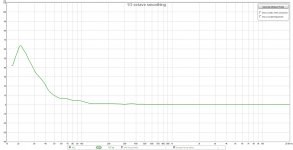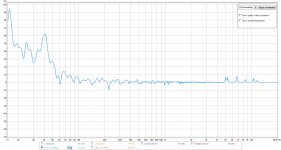In an effort to tighten up the sound in the bass region, ive been trying to correlate what I hear to what I measure.
Ive been doing image searches seeing what other peoples measured Group Delays are. Then it occurred to me, in what manner are they measuring this? Nearfield? Farfield? What? Certainly the answer to this question has a bearing on what measured results are bad or good.
Here is what I am getting at my listening position (variable smoothing).
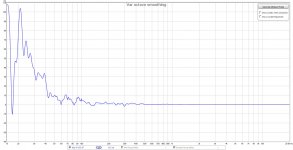
If what I read and see on the web is being understood by me, it looks like I am good >42hz. Fair in the 30-40hz region, and not so great <30hz.
Ive been doing image searches seeing what other peoples measured Group Delays are. Then it occurred to me, in what manner are they measuring this? Nearfield? Farfield? What? Certainly the answer to this question has a bearing on what measured results are bad or good.
Here is what I am getting at my listening position (variable smoothing).

If what I read and see on the web is being understood by me, it looks like I am good >42hz. Fair in the 30-40hz region, and not so great <30hz.
Last edited:
Turn on 1/3rd octave smoothing to remove the ripples from small freq response fluctuations. The graph you have is quite good. It is tough to do much better unless you go with an open baffle dipole bass unit. My measurements of group delay in a sealed box match the predictions and for my RS225 in a 24 liter sealed, I get about 8ms at 40Hz with a mild high pass filter and 5.4ms with no high pass filter and 2.5ms at 100Hz. The more higher order EQ and filters you use, the more GD you get. It is tough to get it much lower in the 30Hz region, and really, that region is dominated by room reflections which are in the hundreds of ms so you won't notice it. It is important to keep it as low as possible at the 40Hz-50Hz region as that is where the kickdrum is centered. The timing and rhythm of much rock and jazz is governed by the kickdrum and the 41Hz of the bass guitar.
Here is the GD on my 10F/8424-RS225 FAST system without a high pass filter - about 5ms, and 5ms sounds very very good for timing coherence relative to 2ms delay at 100Hz:
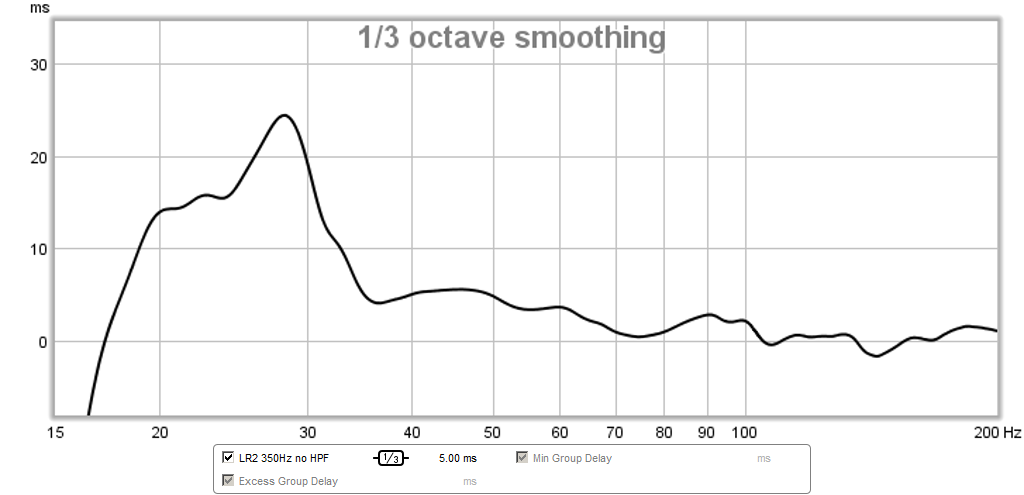
But if I add a Linkwitz transform and a mild high pass, I get about 8ms:
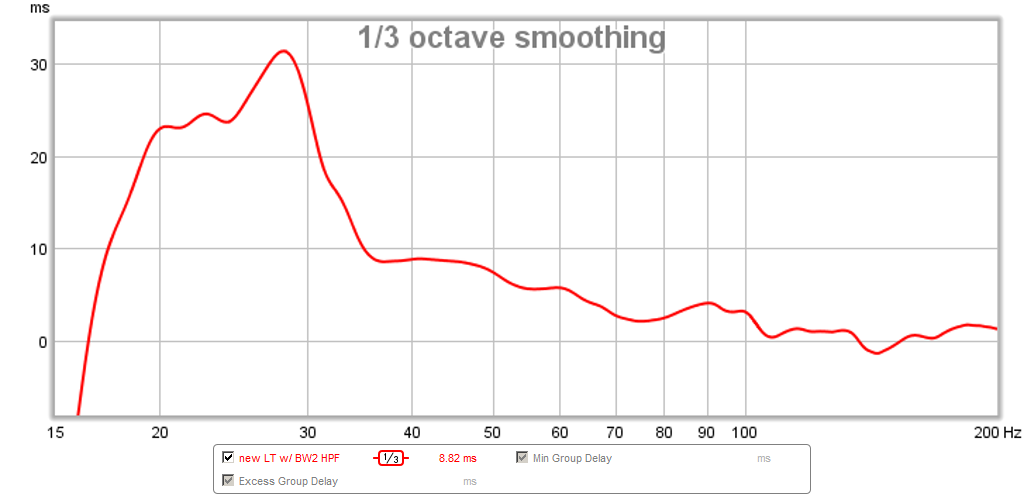
Here is the GD on my 10F/8424-RS225 FAST system without a high pass filter - about 5ms, and 5ms sounds very very good for timing coherence relative to 2ms delay at 100Hz:

But if I add a Linkwitz transform and a mild high pass, I get about 8ms:

It is important to keep it as low as possible at the 40Hz-50Hz region as that is where the kickdrum is centered. The timing and rhythm of much rock and jazz is governed by the kickdrum and the 41Hz of the bass guitar.
Most of the music I listen to is a Rock variant (Progressive, Fusion, Classic) and indeed the 40-50hz region is critical.
FYI, My mains and (1) sub (2x10" woofers) are ported. (2) more subs (1x10" woofers each) are sealed. So I am finding it very tricky to get everything to integrate properly.
Last edited:
Nearfield as at LP it is room reflection dominated and makes less sense. If I had an anechoic room, then you would still measure same GD. It doesn't change with propagation distance.
Most of the music I listen to is a Rock variant (Progressive, Fusion, Classic) and indeed the 40-50hz region is critical.
FYI, My mains and (1) sub (2x10" woofers) are ported. (2) more subs (1x10" woofers each) are sealed. So I am finding it very tricky to get everything to integrate properly.
Your GD of 22ms at 40Hz is typical of a bass reflex system. If you want cleaner bass so kick drums and bass guitar are tight, I recommend going with sealed box. Simple sealed box and a decent driver with decent xmax and low distortion motor. That should get you down to the circa 8ms like I have at 40Hz. Use Linkwitz transform if your box driver combo doesn't naturally do f3 of 40Hz.
Your GD of 22ms at 40Hz is typical of a bass reflex system. If you want cleaner bass so kick drums and bass guitar are tight, I recommend going with sealed box. Simple sealed box and a decent driver with decent xmax and low distortion motor. That should get you down to the circa 8ms like I have at 40Hz. Use Linkwitz transform if your box driver combo doesn't naturally do f3 of 40Hz.
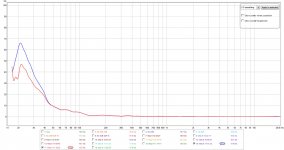
Just for grins, I stuffed the sub port (red). It did help, but not a whole lot at 40hz.
Nearfield as at LP it is room reflection dominated and makes less sense. If I had an anechoic room, then you would still measure same GD. It doesn't change with propagation distance.
Are you saying the room doesnt effect GD measurements? I get different GD measurements by merely shutting the doors to adjacent rooms.
Are you saying the room doesnt effect GD measurements? I get different GD measurements by merely shutting the doors to adjacent rooms.
They do of course, but there is nothing that the speaker can intrinsically do about that - you have to put in room treatments and bass traps etc. We are talking about the speaker's GD. Room induced GD is all placement, room, doors, windows, carpeting, and how much junk and curios you have lying about. And all of that is highly user dependent. I don't think anyone talks about speaker GD with room effects included. You are talking about room reverb effects I think?
They do of course, but there is nothing that the speaker can intrinsically do about that - you have to put in room treatments and bass traps etc. We are talking about the speaker's GD. Room induced GD is all placement, room, doors, windows, carpeting, and how much junk and curios you have lying about. And all of that is highly user dependent. I don't think anyone talks about speaker GD with room effects included. You are talking about room reverb effects I think?
My room is heavily treated. Many of my absorbers are 18" - 24" thick (pink fluffy).
That said, what interests me is what is heard. And that takes place at the LP. My posted measurements are at the LP. I dont see how the room cant be included if we are talking about the observed (heard) tightness of bass.
Certainly what the speaker does on its own is important. But whatever measurements you apply to the speaker only isnt what your going to hear. Unless you take the speaker outside, I am not sure how you can remove the room looking at low frequency measurements.
This is what I meant when I asked how people are measuring GD. Is it the speaker only typically, or is the room included also.
Last edited:
Can you repeat your GD measurements near field (0.5m) and see how it looks? Please show freq response as well as Impulse Response at near field and LP. Then, if your GD at LP is about the same, then you know source of extra GD.
I agree room is important - but that is an ambient effect and same as why music sounds different in room vs an auditorium or stadium.
I agree room is important - but that is an ambient effect and same as why music sounds different in room vs an auditorium or stadium.
Can you repeat your GD measurements near field (0.5m) and see how it looks? Please show freq response as well as Impulse Response at near field and LP. Then, if your GD at LP is about the same, then you know source of extra GD.
I agree room is important - but that is an ambient effect and same as why music sounds different in room vs an auditorium or stadium.
Near field to which source?
Main L
Main R
Sub 1
Sub 2
Sub 3
No matter which you choose, the readings are going to change substantially over those taken at the LP.
Ok I see your point as you have a separate sub. How is each sub given its signal ? The third is a L+R matrix?
I would still do a near field of each speaker's GD. Even the sub all by itself over its pass band. Your room LP GD is only as good as the limiting longest one. Let's find out what the intrinsic GD is. If you are HP filtering your L R mains above say 80Hz then it's not contributing to the GD at 40-50Hz.
With 3 subs in different spots your GD will vary with measurement location. Just the plain physics of it. Delay is about 1ft per millisecond. So moving around in the room is going to mess that up.
Now that I see your system more fully I am not sure there is anything you can do to clean it up apart from having a single sub located underneath your sofa where the LP is. Then use DSP to set the time alignment between your mains and the sub. Oh, and the sub needs to be a sealed one with intrinsically low GD to start with.
I would still do a near field of each speaker's GD. Even the sub all by itself over its pass band. Your room LP GD is only as good as the limiting longest one. Let's find out what the intrinsic GD is. If you are HP filtering your L R mains above say 80Hz then it's not contributing to the GD at 40-50Hz.
With 3 subs in different spots your GD will vary with measurement location. Just the plain physics of it. Delay is about 1ft per millisecond. So moving around in the room is going to mess that up.
Now that I see your system more fully I am not sure there is anything you can do to clean it up apart from having a single sub located underneath your sofa where the LP is. Then use DSP to set the time alignment between your mains and the sub. Oh, and the sub needs to be a sealed one with intrinsically low GD to start with.
Ok I see your point as you have a separate sub. How is each sub given its signal ? The third is a L+R matrix?
I would still do a near field of each speaker's GD. Even the sub all by itself over its pass band. Your room LP GD is only as good as the limiting longest one. Let's find out what the intrinsic GD is. If you are HP filtering your L R mains above say 80Hz then it's not contributing to the GD at 40-50Hz.
With 3 subs in different spots your GD will vary with measurement location. Just the plain physics of it. Delay is about 1ft per millisecond. So moving around in the room is going to mess that up.
Now that I see your system more fully I am not sure there is anything you can do to clean it up apart from having a single sub located underneath your sofa where the LP is. Then use DSP to set the time alignment between your mains and the sub. Oh, and the sub needs to be a sealed one with intrinsically low GD to start with.
We are bordering on a complete system analysis. My system is complicated and a little unconventional. So you probably dont want to go there.
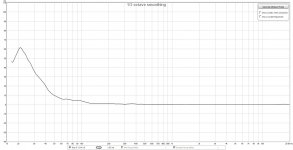
Lets go back to this. Which part needs the most work you think? The 20ms at 40hz I am guessing?
To answer some your questions:
Mains (full range)(no XO) Ported (32hz tuning)(2x100w)
Sub 1 (40hz XO 24db/oct) Ported (22hz tuning)(R+L)(2x10" woofers)(250W)
Sub 2 (60hz XO 24db/oct) Sealed (R+L)(1x10" woofer)(75W)
Sub 3 (60hz XO 24db/oct) Sealed (L)(1x10" woofer)(75W)
I dont use an AVR. I am old school.
My signal chain is straightforward: CD->DAC->Passive Pre->Power-Amp->Subs
Last edited:
Lets go back to this. Which part needs the most work you think? The 20ms at 40hz I am guessing?
Yes, and I am guessing that given you are using ported bass reflex, the majority of the GD is caused by the sub's response at 40Hz (or rather the curvature of the response).
Do you have your sub driver model number or TS params? Also box volume and port area and length? I can model it and see what kind of GD is predicted. Oftentimes, changing what you are using for a high pass protection filter can reduce the GD. I had a 4th order BW high pass filter at about 27Hz on my bass unit and simply taking that out brought the GD from 15ms to 5ms. Using a less aggressive 2nd order HP filter took the GD from 15ms to 8ms. A substantial improvement. It might be more difficult with a proted alignment as 15ms to 20ms may just be the best you get.
Yes, and I am guessing that given you are using ported bass reflex, the majority of the GD is caused by the sub's response at 40Hz (or rather the curvature of the response).
Do you have your sub driver model number or TS params? Also box volume and port area and length? I can model it and see what kind of GD is predicted. Oftentimes, changing what you are using for a high pass protection filter can reduce the GD. I had a 4th order BW high pass filter at about 27Hz on my bass unit and simply taking that out brought the GD from 15ms to 5ms. Using a less aggressive 2nd order HP filter took the GD from 15ms to 8ms. A substantial improvement. It might be more difficult with a proted alignment as 15ms to 20ms may just be the best you get.
The filters are built into the plate amps, so I really can change them.
Sub 1 amp:
Dayton Audio SPA250 250 Watt Subwoofer Plate Amplifier
Subs 2&3 amps:
Dayton Audio SA100 100W Subwoofer Plate Amplifier
All the subs use this woofer. Sub 1 uses two of them.
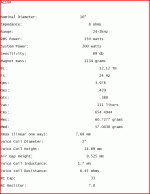
Sub 1 is a 5.8 cu ft box with a 4.25" diameter port extended to yield a 22hz tuning.
Subs 2&3 are in sealed 1.1 cu ft enclosures, stuffed optimally to yield about a 1.4 cu ft see size.
----- ---- ---- ---- ----
Having test each at the LP, I can say that the 40hz is a combination of the mains and sub1 (both ported)
The mains are: Jenzen-NEXT
Last edited:
So you have the ported bass reflex not TL version of the NEXT? Very nice speaker by the way. A true multi way speaker so why am are you in the full range forum? I can still look at this but it is getting more complicated.
So you have the ported bass reflex not TL version of the NEXT? Very nice speaker by the way. A true multi way speaker so why am are you in the full range forum? I can still look at this but it is getting more complicated.
Yes.
I choose this forum because GD can be a problem at any frequency. Could have put it in the subwoofer forum. But my mains are involved given their fullrange and no XO.
I told you things might get complicated. Your not on the hook for anything. You have put some time into this already, and I appreciate it.
At the end of the day, given all the the ported boxes, like you said, things may be already about as good as they will get.
Just realized what you meant by forum. Yes, this should be in the multi-way or sub forum 😱
Perhaps a moderator would be kind enough to move it?
Perhaps a moderator would be kind enough to move it?
- Status
- Not open for further replies.
- Home
- Loudspeakers
- Full Range
- Group Delay Questions and Analysis
